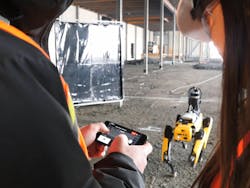An architecture project in London has been using Boston Dynamics’ four-legged robot, Spot, to gather data from a construction site and map out a digital twin of its office space. The project—the Battersea Roof Gardens development in London—had been utilized as a testbed for the four-legged robot, which can be controlled by a human from a distance or follow a predefined route.
The collaboration involved the architecture company’s Applied Research and Development group working alongside a team from Boston Dynamics. At the Battersea project, a map and associated “missions” were created for the robot to follow so it could scan specific areas and collate data. It came back to the site at weekly intervals in order to run its missions.
Martha Tsigkari, a partner at the architecture firm, described the robot’s ability to repeatedly complete routine scans in “an ever-changing environment” as “invaluable not only in terms of the consistency but also the large amount of high-quality data collected.”
In addition to the construction site in Battersea, the robot was also deployed at Foster + Partners’ London campus, where it was used to create a digital twin of that space. To do this, a four dimensional model of the area was formed, allowing those involved in the project to see how the space changes as time passes.
“Combining temporal and spatial information with data from sensors that read environmental conditions and occupancy, we can construct an intricate model of how people, furnishings and environmental conditions interact,” Adam Davis, a partner at Foster + Partners, said in a statement.





